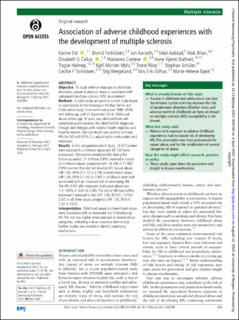| dc.contributor.author | Eid, Karine | |
| dc.contributor.author | Torkildsen, Øivind | |
| dc.contributor.author | Aarseth, Jan Harald | |
| dc.contributor.author | Aalstad, Mari | |
| dc.contributor.author | Bhan, Alok | |
| dc.contributor.author | Celius, Elisabeth Gulowsen | |
| dc.contributor.author | Cortese, Marianna | |
| dc.contributor.author | Daltveit, Anne Kjersti Nesje | |
| dc.contributor.author | Holmøy, Trygve | |
| dc.contributor.author | Myhr, Kjell-Morten | |
| dc.contributor.author | Riise, Trond | |
| dc.contributor.author | Schuler, Stephan | |
| dc.contributor.author | Torkildsen, Cecilie Fredvik | |
| dc.contributor.author | Wergeland, Stig | |
| dc.contributor.author | Gilhus, Nils Erik | |
| dc.contributor.author | Bjørk, Marte-Helene | |
| dc.date.accessioned | 2022-08-15T08:20:52Z | |
| dc.date.available | 2022-08-15T08:20:52Z | |
| dc.date.created | 2022-05-13T12:40:57Z | |
| dc.date.issued | 2022 | |
| dc.identifier.issn | 0022-3050 | |
| dc.identifier.uri | https://hdl.handle.net/11250/3011781 | |
| dc.description.abstract | Objective To study whether exposure to childhood emotional, sexual or physical abuse is associated with subsequent multiple sclerosis (MS) development.
Methods A nationwide, prospective cohort study based on participants in the Norwegian Mother, Father and Child cohort study. Enrolment took place 1999–2008, with follow-up until 31 December 2018. Childhood abuse before age 18 years was obtained from self-completed questionnaires. We identified MS diagnoses through data-linkage with national health registries and hospital records. The Cox model was used to estimate HRs for MS with 95% CIs, adjusting for confounders and mediators.
Results In this prospective cohort study, 14 477 women were exposed to childhood abuse and 63 520 were unexposed. 300 women developed MS during the follow-up period. 71 of these (24%) reported a history of childhood abuse, compared with 14 406 of 77 697 (19%) women that did not develop MS. Sexual abuse (HR 1.65, 95% CI 1.13 to 2.39) and emotional abuse (HR 1.40, 95% CI 1.03 to 1.90) in childhood were both associated with an increased risk of developing MS. The HR of MS after exposure to physical abuse was 1.31 (95% CI 0.83 to 2.06). The risk of MS was further increased if exposed to two (HR 1.66, 95% CI 1.04 to 2.67) or all three abuse categories (HR 1.93, 95% CI 1.02 to 3.67).
Interpretation Childhood sexual and emotional abuse were associated with an increased risk of developing MS. The risk was higher when exposed to several abuse categories, indicating a dose–response relationship. Further studies are needed to identify underlying mechanisms. | en_US |
| dc.language.iso | eng | en_US |
| dc.publisher | BMJ | en_US |
| dc.rights | Navngivelse-Ikkekommersiell 4.0 Internasjonal | * |
| dc.rights.uri | http://creativecommons.org/licenses/by-nc/4.0/deed.no | * |
| dc.title | Association of adverse childhood experiences with the development of multiple sclerosis | en_US |
| dc.type | Journal article | en_US |
| dc.type | Peer reviewed | en_US |
| dc.description.version | publishedVersion | en_US |
| dc.rights.holder | Copyright 2022 The Author(s) | en_US |
| cristin.ispublished | true | |
| cristin.fulltext | original | |
| cristin.qualitycode | 2 | |
| dc.identifier.doi | 10.1136/jnnp-2021-328700 | |
| dc.identifier.cristin | 2024330 | |
| dc.source.journal | Journal of Neurology, Neurosurgery and Psychiatry | en_US |
| dc.source.pagenumber | 645-650 | en_US |
| dc.relation.project | Norges forskningsråd: 288164 | en_US |
| dc.relation.project | Helse Vest RHF: F-12503 | en_US |
| dc.identifier.citation | Journal of Neurology, Neurosurgery and Psychiatry. 2022, 93 (6), 645-650. | en_US |
| dc.source.volume | 93 | en_US |
| dc.source.issue | 6 | en_US |

